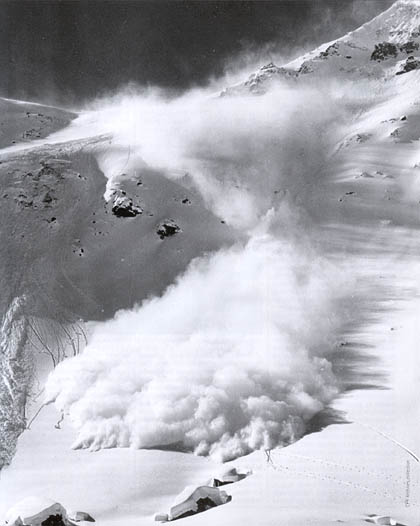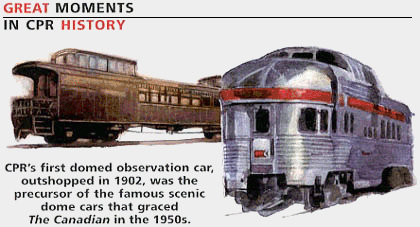 |
 |
|
|
|
|
CPR Magazine Article
|
Spring
2004

Canadian Pacific
Railway Employee Communications
Room 500 401-9th Ave S.W. Calgary AB
T2P 4Z4
AVALANCHE!

CPR Archives
collection.
Despite the essential contribution
railways make to the overall health of the North American transportation network, the
twin bands of steel often appear to have no more than a tenuous foothold in the vast
sea of mountains they traverse - and never is that more true than when heavy
snowfalls, winter conditions, and bad luck conspire to humble even the most prepared
railroaders.
Even as the CPR transcontinental main line was being constructed westward toward the
Rocky and Selkirk mountain ranges, in the early 1880s, railway surveyors were awed by
the raw power of the avalanches they observed in the direct path of the advancing
rails. Major A.B. Rogers, of Rogers Pass fame, had reported the prevalence of spring
avalanches to head office while conducting his initial assessment of the route through
the mountains. And, in February 1885, just nine months before the completion of the
historic east-west link, James Ross, engineer-in-charge,
wrote to general manager William Van Horne about his serious misgivings.
"The great trouble we are labouring under at the present is that the men are
frightened," Ross related. "Seven have already been buried in slides,
though fortunately only two were killed. I find the snow slides in the Selkirks are
much more serious than I anticipated, and I think quite beyond your ideas of their
magnitude and the danger to the line."
If there were any doubts as to the disruptive potential of the millions of tons of
ice and snow that could at a moment's notice tumble down a mountain side at more than
100 miles per hour, sweeping aside anything in their path, they were dispelled during
the winter of 1885-86. That year, with the transcontinental line completed but
unprotected from the vagaries of winter, the railway was temporarily abandoned.
Observation camps, established to record the amount of snowfall and the frequency of
avalanche occurrences, determined where snowsheds would be built and snowfighting
equipment would be stationed to support winter operations. With annual snowfalls in
excess of 50 feet in some areas, and nearly as much occasionally dumped on the main
line in a single slide, it was not a pretty picture.
The worst incident occurred in the winter of 1910 as CPR workers worked to clear a
slide that had tumbled down from Mt. Cheops at the west end of Rogers Pass. While
they struggled to reopen the line - largely with hand shovels - an even worse deluge
of snow roared down one of the long sweeping slide paths on the
aptly-named Mt. Avalanche, towering on the opposite side of the narrow
passage. Sixty-two men were killed. A 100-ton rotary
snowplow, of limited use clearing the first slide due to the amount of broken trees
and other debris that came to rest on the roadbed, now lay on its side. Hundreds of
feet of showshed had been demolished.
It was the final straw that led to the CPR's decision to build the
double-track Connaught Tunnel under Mount Macdonald, thereby avoiding
the most dangerous section of the pass. The five mile (eight kilometre) bore was one
of the most spectacular engineering feats in North America, until the 1980s, when the
nine mile (14.5 kilometre) Mount Macdonald Tunnel was driven beneath the same
treacherous peaks, just below the Connaught Tunnel.
The Macdonald Tunnel now handles heavier CPR westbound trains, while the Connaught
takes eastbound traffic. The twin bores, along with the addition of hundreds of feet
of reinforced concrete showshed, have gone a long way toward making the route through
the Selkirks more tenable in winter; but CPR railroaders can never let their guards
down.
Avalanches have killed hundreds of railroaders over the years; they have knocked
bridges from their abutments; they have closed the CPR main line for days and weeks
at a time. At the same time, though, many strategies have been put in place to
mitigate the effects of the giant, killer snow slides, prevent the tragic loss of
workers and keep traffic moving on what continues to be an essential economic
lifeline.
In partnership with provincial governments, National Parks, and the men and women who
labour to keep the Trans-Canada Highway open through the winter months,
CPR now has access to continuous weather monitoring services, detailed snowpack
observations, and sophisticated sensors high above the tree line where avalanches
occur. The Canadian Armed Forces fire howitzer artillery guns, under the guidance of
skilled avalanche observers, to trigger slides under controlled conditions. And the
railway's track forces wait to clear whatever winter might throw at them - and spread
it away from the roadbed to make way for the next onslaught.
In addition, CPR is proud to partner with the Canadian Avalanche Association to
increase awareness and avoid the deadly consequences of one of nature's most
destructive forces.
Today in the mountain passes, during the warmer months, you can see the heavy, black
plows and spreaders sitting idly in the hot summer sun, like old workhorses put out
to pasture.
But when the snow starts to fly, they venture out from their yards in Revelstoke,
Golden, and Cranbrook to patrol up and down the line, fighting the fight that ebbs
and flows but never ends and - when Old Man Winter does his worst - still clearing
the tons of snow and ice that annually cascade down the mountains in avalanches.


This Momentum article is
copyright 2004 by Canadian Pacific Railway and is reprinted here with their
permission. All photographs, logos, and trademarks are the property of the Canadian
Pacific Railway Company.
|
|
|
|